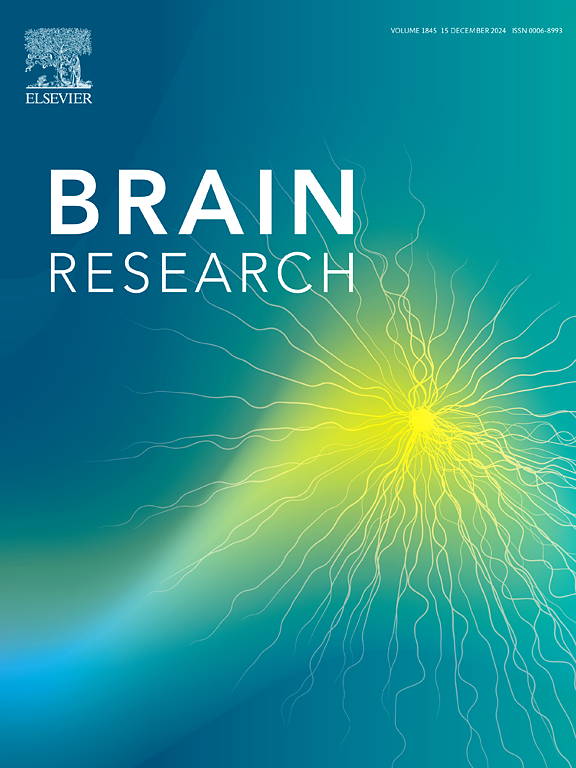地奥司明通过RSK2/CREB通路缓解中风后NLRP3炎症体依赖性细胞脓毒症。
IF 2.7
4区 医学
Q3 NEUROSCIENCES
引用次数: 0
摘要
接上文分析了针对中风失语症的经典方剂积玉丹的主要有效成分,我们进一步研究了积玉丹的有效成分薯蓣皂甙(DM)在缺血性中风中的功能和机制,它可能具有神经保护作用。在此,生物信息学分析揭示了DM的靶点及其与缺血性脑卒中差异表达基因的交叉。研究人员利用大脑中动脉闭塞(MCAO)大鼠和氧-葡萄糖剥夺(OGD)细胞构建了缺血性脑卒中的体内和体外模型。通过Zea-Longa评分、Morris水迷宫、TTC染色、Nissl染色、免疫组化和Western印迹等方法评估了DM对MCAO大鼠的影响。在细胞水平上,通过细胞计数试剂盒-8检测和Western印迹来验证DM在缺血性脑卒中中的作用机制。在体内,DM降低了MCAO大鼠的神经功能缺损评分、脑梗死体积和神经元损伤,改善了认知功能。在体外,DM提高了OGD处理细胞的活力。此外,DM还能下调NLR家族含吡咯啉结构域3(NLRP3)和裂解相关蛋白的表达,同时上调核糖体蛋白S6激酶A3(RSK2)水平,激活环-AMP反应元件结合蛋白(CREB)信号转导。相反,RSK2抑制剂LJH685可降低细胞活力,促进细胞内热休克相关蛋白水平的升高,并部分逆转DM在体外的作用。总之,DM通过RSK2/CREB途径抑制NLRP3炎性体介导的细胞热凋亡,从而在缺血性中风中发挥治疗作用。本文章由计算机程序翻译,如有差异,请以英文原文为准。
Diosmin alleviates NLRP3 inflammasome-dependent cellular pyroptosis after stroke through RSK2/CREB pathway
In the context of our previous analyses on the main active ingredients of Jieyudan, a classic formula targeting aphasia in stroke, we further delve into the function and mechanisms of its active ingredient, Diosmin (DM), which may exert neuroprotective effects, in ischemic stroke. Herein, bioinformatics analysis revealed targets of DM and their intersection with differentially expressed genes in ischemic stroke. Middle cerebral artery occlusion (MCAO) rats and oxygen-glucose deprivation (OGD) cells were used to construct in vivo and in vitro models of ischemic stroke. The effects of DM on MCAO rats were assessed by Zea-Longa score, Morris water maze, TTC staining, Nissl staining, immunohistochemistry, and Western blot. At the cellular level, cell counting kit-8 assay and Western blot were carried out to verify the mechanism of DM in ischemic stroke. In vivo, DM decreased neurological deficit score, cerebral infarct volume and neuronal damage, and improved cognitive function in MCAO rats. In vitro, DM increased the viability of OGD-treated cells. In addition, DM down-regulated the expressions of NLR family pyrin domain containing 3 (NLRP3) and pyroptosis-associated proteins, while up-regulating ribosomal protein S6 kinase A3 (RSK2) level and activating cyclic-AMP response element-binding protein (CREB) signaling. Conversely, RSK2 inhibitor LJH685 reduced the viability and promoted pyroptosis-associated protein levels, which also partially reversed the effects of DM in vitro. Collectively, DM plays a therapeutic role in ischemic stroke by inhibiting NLRP3 inflammasome-mediated cellular pyroptosis via the RSK2/CREB pathway.
求助全文
通过发布文献求助,成功后即可免费获取论文全文。
去求助
来源期刊

Brain Research
医学-神经科学
CiteScore
5.90
自引率
3.40%
发文量
268
审稿时长
47 days
期刊介绍:
An international multidisciplinary journal devoted to fundamental research in the brain sciences.
Brain Research publishes papers reporting interdisciplinary investigations of nervous system structure and function that are of general interest to the international community of neuroscientists. As is evident from the journals name, its scope is broad, ranging from cellular and molecular studies through systems neuroscience, cognition and disease. Invited reviews are also published; suggestions for and inquiries about potential reviews are welcomed.
With the appearance of the final issue of the 2011 subscription, Vol. 67/1-2 (24 June 2011), Brain Research Reviews has ceased publication as a distinct journal separate from Brain Research. Review articles accepted for Brain Research are now published in that journal.
 求助内容:
求助内容: 应助结果提醒方式:
应助结果提醒方式:


